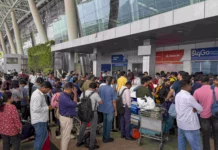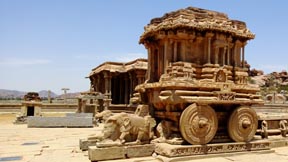 Every inch the capital city of a golden empire
Every inch the capital city of a golden empire
From atop the Matanga Hill at daybreak, Hampi is every inch the capital city of a golden empire. Though what lies before are but the bones of an enchantress, who once had the whole world in her sway, Hampi is far from what one would call ruins. Once visited by the Portuguese, Arabs, Persians and Orientals, the capital city of Vijayanagara, has only grown in popularity across the centuries. And no surprise that!
Every bend in the road is punctuated by a 14th century, if not older, temple; perched on nearly every hillock is a four-pillared canopy-like monument and its entire horizon, pixilated by huge gestalt-ish boulders. The regal 9-storey tall gopura of the Virupaksha Temple, where Siva is believed to have married Parvati, watches over the city like a specially-appointed god – its memory of magnificence and grandeur forever etched in stone.
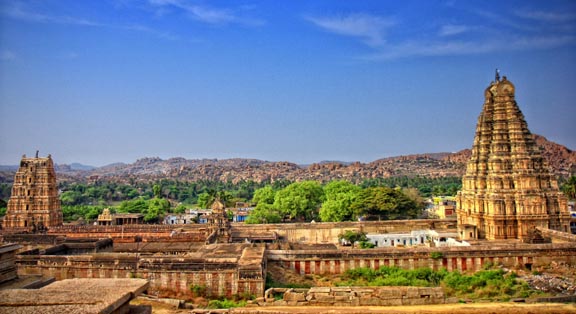 Hampi gives an impression of preserving itself for the past to resume. The wedding ceremony of Shiva and Parvati is celebrated every year at the Virupaksha Temple, as it has been for centuries. The long bazaar avenues stand in expectant silence, as if waiting for that kind of commerce to resume, where diamonds and precious stones were used as currency.
Hampi gives an impression of preserving itself for the past to resume. The wedding ceremony of Shiva and Parvati is celebrated every year at the Virupaksha Temple, as it has been for centuries. The long bazaar avenues stand in expectant silence, as if waiting for that kind of commerce to resume, where diamonds and precious stones were used as currency.
In the evenings, like a zillions dusks before, the dying rays of the sun turn the entire Vijaya Vittala Temple to gold; a sight which is as much a wonder as the temple’s 56 musical pillars that produce the sounds of 56 different musical instruments. The Royal Enclosure waits in readiness for its sandalwood halls to be returned, the massive elephant stables, the Lotus Mahal – shaped like a lotus blossoming in the sun, the Hazararama Palace temple with intricate stories carved over its every side and the Mahanavmi Dibba or the Victory Platform still majestic and proud await to fall back into routine.
The sheer detail of the carvings and the number of sculptures speak of a race of artisans that weren’t quite done in their business of outdoing each other in craftsmanship. Monolithic structures carved out of a single rock the imposing Lakshmi Narasimha, the majestic Stone Chariot, the massive Ganesha statues, the Badavilinga are proof of the brilliance that was once envied. Cross the Tungabadra River over to the ancient capital of Anegundi and there are leisurely roads to traverse, myths to chase and boulders to scale and dive off, into the waiting arms of the Sanapur Lake.
Hampi has challenged time, survived the centuries and lived to tell the tale. And, they say, if you listen carefully enough, you might learn a thing or two on how to do the same.
Tourist attractions in Hampi lie in its boulder-laden landscape and rocky outcrop hemmed in a lush green surrounding. The ruins remind you of a mighty empire, which dominated large part of south India after the Mughals.
Places to see
Hampi Bazaar
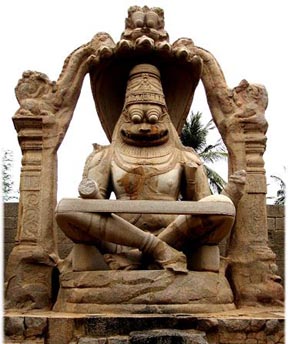 Located near the Virupaksha Temple, the Hampi Bazaar is also known as Virupaksha Bazaar. On either sides of this one kilometer long street near the temple, are pavilions which were once a part of the markets of the nobles. Most of these pavilions, particularly towards the west of Virupaksha Temple have shops and restaurants. The street is congested and therefore, most of the vehicles are restricted in the bazaar except for two wheelers.
Located near the Virupaksha Temple, the Hampi Bazaar is also known as Virupaksha Bazaar. On either sides of this one kilometer long street near the temple, are pavilions which were once a part of the markets of the nobles. Most of these pavilions, particularly towards the west of Virupaksha Temple have shops and restaurants. The street is congested and therefore, most of the vehicles are restricted in the bazaar except for two wheelers.
Matanga Hill
Matanga hill is a well known tourist destination in Hampi. Its main attraction being the breathtaking aerial view of the Hampi landscape during sunset or sunrise. When on top, you can appreciate the sheer wisdom of the Vijaynagara rulers for selecting Hampi as their capital. The best track for trekking enthusiasts is the one that begins from Hampi bazaar to the Achyutaraya temple. The picturesque sight from the top comprises the Tungabhadra River, the Kodanda Rama temple, the Veerbhadra temple and the Turthu canal. Matanga hill is historically connected to the epic Ramayana as it was the hiding place for Sugriva, the ruler of Kishkinda.
Vithala Temple Complex
A unique architectural masterpiece, Vithala temple in Hampi is situated opposite the village of Anegondi. The temple is named after Vithala, an avatar of Vishnu worshipped by the Marathas.
Vithala temple is built in the form of a complex with compound wall and gateway towers. The one thing that immediately catches attention is the stone chariot which has assumed iconic heights over the years for Karnataka tourism. The pillared halls are intrinsically carved with sculptures that speak volumes about the glorious past of Hampi. Another feature that is worth mentioning here is the musical pillars that emanates the seven notes when tapped.
Hazara Rama Temple
The Hazara Rama temple complex in Hampi is located in the middle of the Royal Centre and was once used as a place of worship by the royal family members. Inscriptions inside the temple indicate that it was built by Devaraya I in early fifteenth century. This temple is renowned for its elaborate frescos extensively portraying scenes from Hindu mythology. There are about one thousand fantastically carved bas relief and inscriptions that illustrate the mighty epic Ramayana and the Mahanavami festival.
Depiction of processions of elephants, horses with attendants, dancing girls and armored soldiers testify the expertise of the Vijayanagara artists.
Lakshmi Narasimha Temple
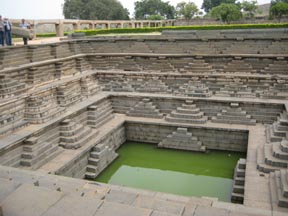 The Lakshmi Narasimha temple in Hampi attracts tourists specifically due to its monolithic structure and the sheer enormity of its size. It is the single largest statue in Hampi with a height of 6.7 meters.
The Lakshmi Narasimha temple in Hampi attracts tourists specifically due to its monolithic structure and the sheer enormity of its size. It is the single largest statue in Hampi with a height of 6.7 meters.
Narasimha, the fourth incarnation of Lord Vishnu is depicted as sitting on the giant coil of the celestial snake Adisesha. The seven heads of the giant snake shielding Narasimha, arched by a Kirtimukha Torana in the front, is an architectural masterpiece in itself. However, several features of the monolithic structure are missing and the most prominent among these damaged and missing structures is the seated figurine of Narasimha’s consort Lakshmi on his left lap. By entering inside the enclosure, one can see the land of Lakshmi on Narasimha’s back with her fingers, nails and rings, all beautifully sculptured.
Virupaksha Temple
Amidst the ruins of the ancient city Vijaynagar the Virupaksha temple stands tall with all its earlier structures still intact. The temple personifies Lord Shiva and is still used for worship. The inside of the temple consists of a sanctum with a mandapam in front, three ante chambers, a pillared hall and an open pillared hall. Among the three towers the eastern tower is the tallest standing at a height of 160 feet and is nine tiered. Virupaksha portrays Lord Shiva and Lord Vishnu in their various avatars. The chariot festival is celebrated in the premises of this temple during the month of February.
Elephant Stables
A large dome shaped building was used as Elephant Stables to house the ceremonial elephants of the royal household. The architectural style of the building has a strong Indo-Islamic influence that gets reflected in its domes and arched gateways. The building consists of eleven chambers amongst which ten of these are crowned with domes. These chambers were used as elephant stables. The metal hooks that were probably used to chain the elephants are still visible in the ceiling of some of the rooms. Special manholes were constructed for the mahouts to facilitate their easy entrance to the elephant compartments.
How to reach
By Air
Bellary is the nearest domestic airport, which is about 60 km away and Bangalore is the nearest international Airport, which is 350 km away. By Bus
Hampi is well connected by KSRTC bus services with all nearby cities.
By Train
Nearest railhead is Hospet, which is nearly 13 km from Hampi.




